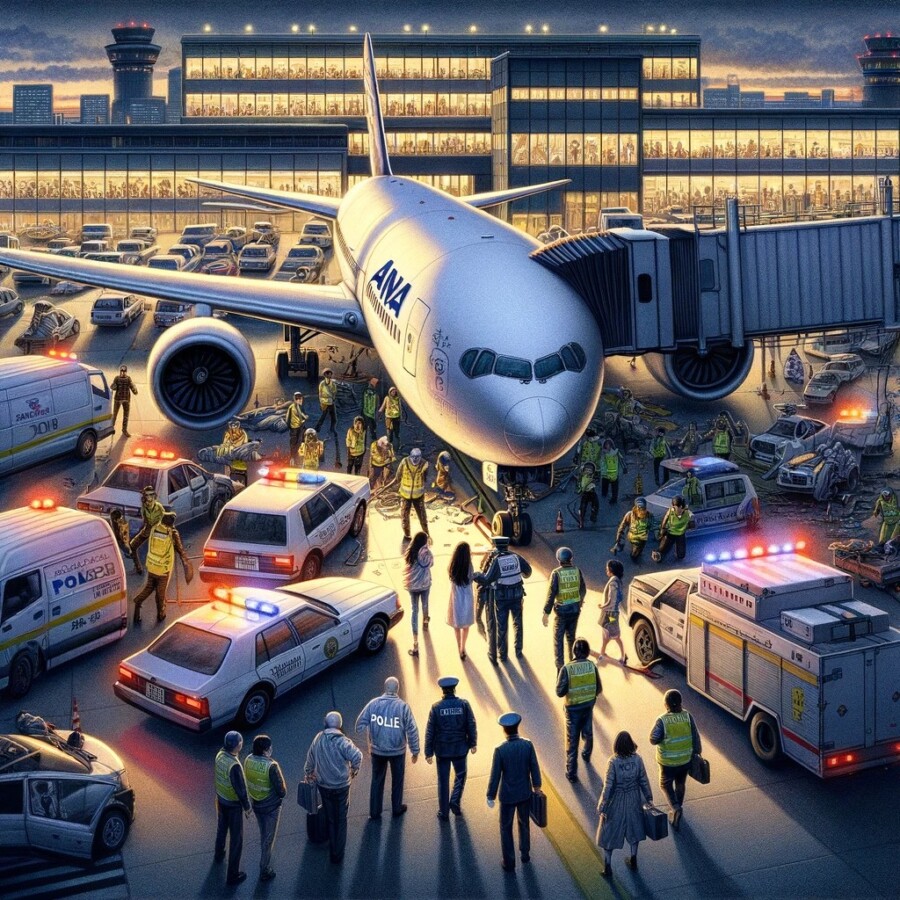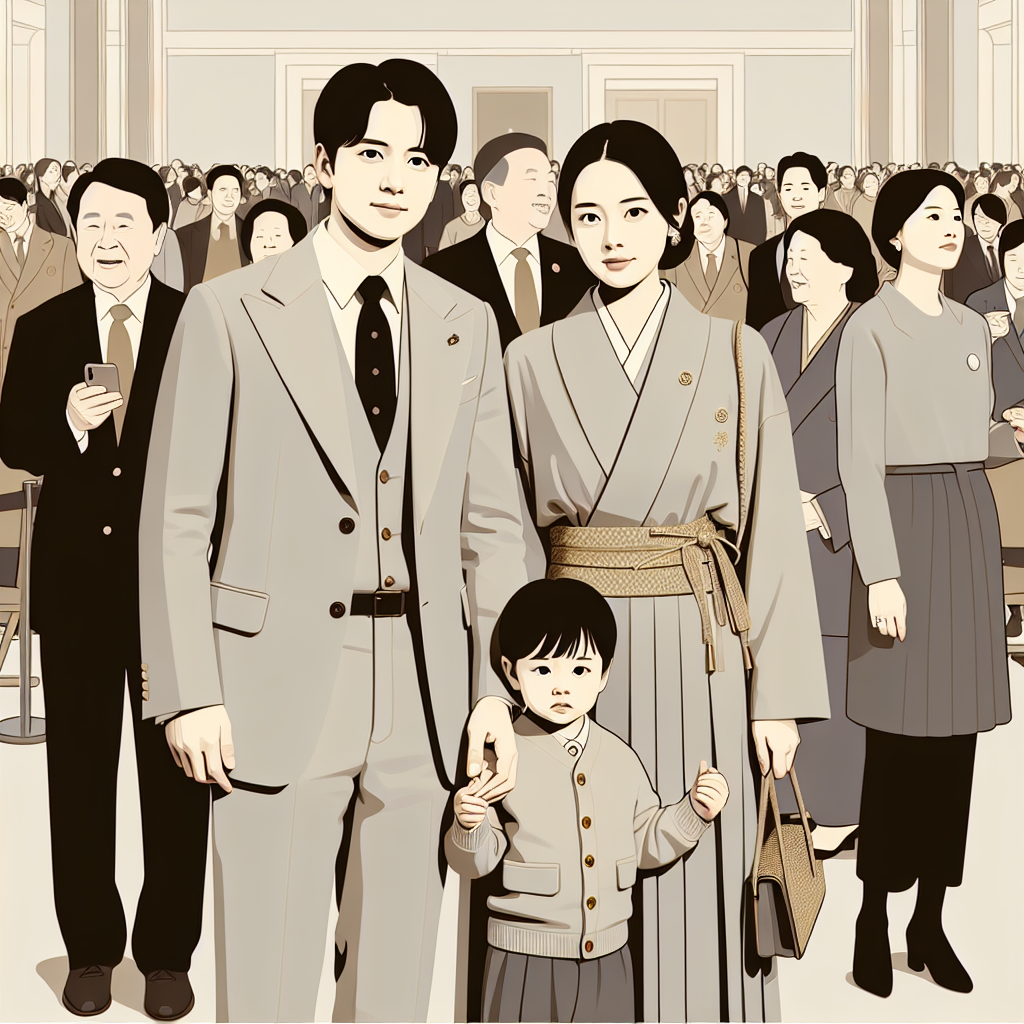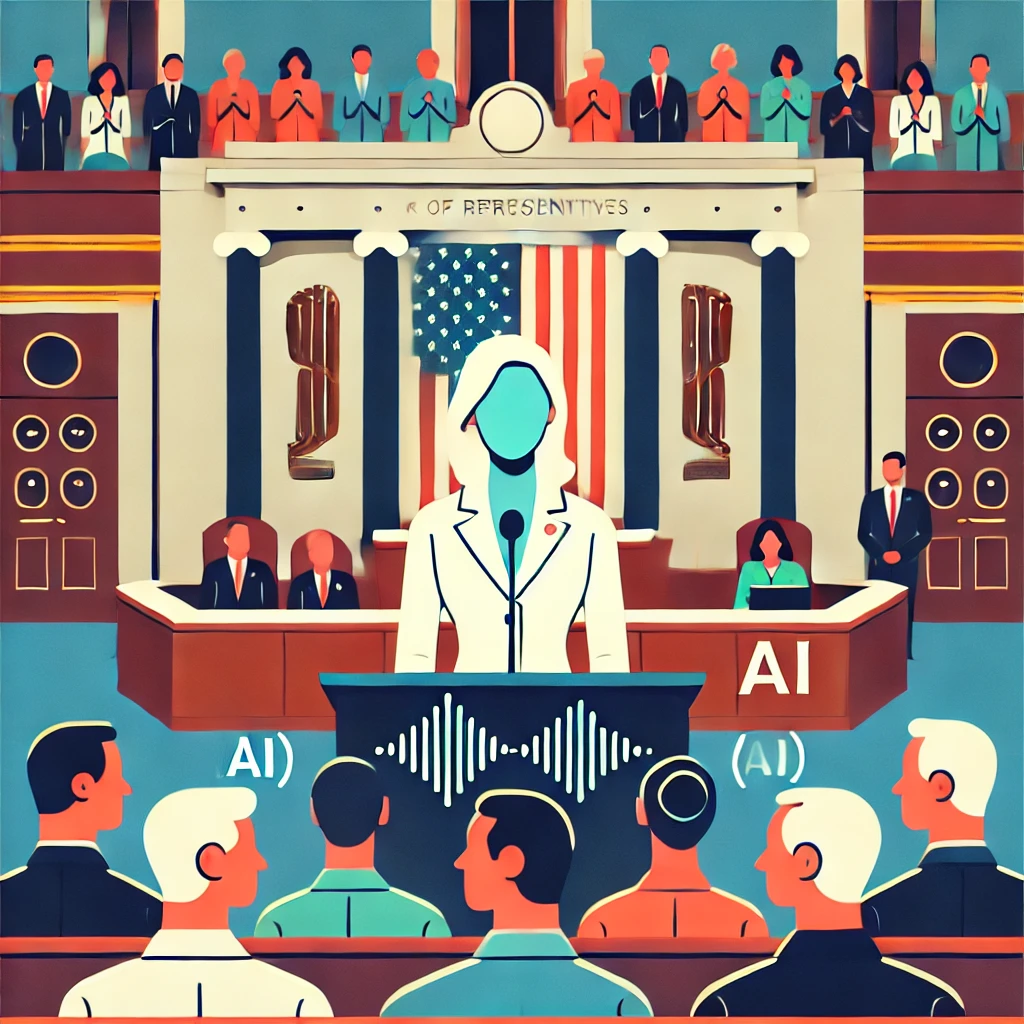A flight from All Nippon Airways (ANA) had to go back to Tokyo because a drunk passenger bit a crew member. The crew member got a small injury. The passenger, who was 55 years old and from America, said he didn’t remember what happened because he took a sleeping pill. This is one of many recent incidents that have affected the Japanese aviation industry.
The plane had 159 passengers and was flying over the Pacific Ocean when the incident happened. The pilots decided to turn back to Tokyo’s Haneda Airport. When they landed, the police took the man. This is the second incident with ANA recently and the fifth incident in a few weeks for the Japanese aviation industry. A few days ago, another ANA flight had to go back because there was a crack in the cockpit window. Luckily, no one got hurt in that incident.
The most serious incident happened on January 2nd at Haneda Airport when a Japanese Airlines plane crashed into a smaller coastguard plane. Everyone on the passenger jet got out before it caught fire, but five out of the six people on the smaller plane died. There have also been other smaller incidents, like planes from Korean Air and Cathay Pacific hitting each other at an airport in Hokkaido, and an ANA plane touching a Delta Air Lines plane at Chicago airport.
These incidents show how important safety is in the aviation industry. Airlines need to make sure that drunk people don’t get on flights because they can cause trouble and hurt crew members and other passengers. It’s also important to regularly check and fix planes to catch any problems before they become serious incidents.
Original news source: Flight returns to Japan after ‘drunk’ man bites crew member (BBC)
🎧 Listen:
Slow
Normal
Fast
📖 Vocabulary:
| 1 | aviation | The activity of flying aircraft |
| 2 | incident | An event, especially one that’s unusual or unpleasant |
| 3 | intoxicated | Drunk or under the influence of alcohol |
| 4 | crew | The group of people who work on a plane |
| 5 | Pacific | The largest ocean on Earth, located between Asia and the Americas |
| 6 | cockpit | The area in a plane where the pilot sits and controls the aircraft |
| 7 | coastguard | A group that protects the coastline and performs search and rescue |
| 8 | jet | A fast plane powered by jet engines |
| 9 | collision | When two objects hit each other with force |
| 10 | Hokkaido | An island in the northern part of Japan |
| 11 | Delta | An airline company known for its triangular logo |
| 12 | preventative | Actions taken to stop something bad from happening |
| 13 | maintenance | The work done to keep something in good condition |
| 14 | imperative | Absolutely necessary or required |
| 15 | repercussions | The effects or consequences that follow an event |
Group or Classroom Activities
Warm-up Activities:
– News Summary
Instructions: Divide the class into pairs. Each pair will have to read the article and summarize it in their own words. They should focus on the main points and key details. After a few minutes, pairs will take turns sharing their summaries with the class.
– Opinion Poll
Instructions: Create a list of discussion questions related to the article. For example: “Do you think airlines should have stricter policies for dealing with drunk passengers?” or “What measures should be taken to improve safety in the aviation industry?” Have the students move around the room and interview their classmates, asking the questions and recording their responses. After a designated time, have the students share their findings with the class.
– Vocabulary Pictionary
Instructions: Write down key vocabulary words from the article on separate pieces of paper. Each student will take turns picking a word and drawing it on the board while the rest of the class guesses what the word is. The student who guesses correctly will then have a turn to draw a word.
– Pros and Cons
Instructions: Divide the class into two groups. Assign one group to represent the airlines and the other group to represent the passengers. Each group will brainstorm and discuss the pros and cons of the recent incidents and their impact on the aviation industry. After a designated time, have the groups present their arguments to the class.
– Future Predictions
Instructions: Have the students work individually or in pairs to write a short paragraph predicting the future of the aviation industry in light of the recent incidents. They should consider potential changes in safety regulations, passenger behavior, and public perception. After a few minutes, have students share their predictions with the class.
🤔 Comprehension Questions:
1. Why did the flight from All Nippon Airways have to go back to Tokyo?
2. How did the crew member get injured?
3. Why did the drunk passenger say he didn’t remember what happened?
4. How many passengers were on the plane when the incident happened?
5. What did the pilots decide to do after the incident?
6. What happened a few days ago on another ANA flight?
7. What was the most serious incident that happened at Haneda Airport?
8. Why is it important for airlines to ensure that drunk people don’t get on flights?
Go to answers ⇩
🎧✍️ Listen and Fill in the Gaps:
A flight from All (1)______ Airways (ANA) had to go back to Tokyo because a drunk (2)______ bit a crew member. The crew member got a small injury. The passenger, who was 55 years old and from America, said he didn’t (3)______ what happened because he took a sleeping pill. This is one of many recent incidents that have affected the Japanese aviation industry.
The plane had 159 (4)______ and was flying over the (5)______ Ocean when the incident happened. The (6)______ decided to turn back to Tokyo’s Haneda Airport. When they landed, the police took the man. This is the second incident with ANA recently and the fifth incident in a few weeks for the Japanese (7)______ industry. A few days ago, another ANA flight had to go back because there was a crack in the (8)______ window. Luckily, no one got hurt in that incident.
The most serious incident (9)______ on January 2nd at Haneda Airport when a Japanese Airlines plane crashed into a smaller coastguard plane. Everyone on the passenger jet got out before it caught fire, but five out of the six people on the smaller plane died. There have also been (10)______ smaller (11)______, like planes from Korean Air and (12)______ Pacific hitting each other at an airport in Hokkaido, and an ANA plane (13)______ a (14)______ Air Lines plane at Chicago airport.
These incidents show how important safety is in the aviation industry. Airlines need to make sure that drunk people don’t get on flights because they can cause (15)______ and hurt crew members and other passengers. It’s also important to regularly check and fix (16)______ to catch any problems before they become serious incidents.
Go to answers ⇩
💬 Discussion Questions:
Students can ask a partner these questions, or discuss them as a group.
1. What is an incident that has recently affected the Japanese aviation industry?
2. How would you feel if you were on a plane that had to turn back because of a drunk passenger?
3. Do you think it’s important for airlines to check passengers for alcohol before they board the plane? Why or why not?
4. How would you feel if you were a crew member on a plane and a passenger bit you?
5. What is the most serious incident that has happened in the Japanese aviation industry recently?
6. How do you think the passengers on the Japanese Airlines plane felt when it crashed into the coastguard plane?
7. Do you think the aviation industry should have stricter safety regulations? Why or why not?
8. How would you feel if you were on a plane that had a crack in the cockpit window?
9. Do you like flying on airplanes? Why or why not?
10. How do you think the crew members on the ANA flights felt after the recent incidents?
11. What is the responsibility of the aviation industry when it comes to ensuring safety?
12. How would you feel if you were on a plane that collided with another plane on the runway?
13. Do you think the recent incidents will affect people’s willingness to fly with ANA or other Japanese airlines? Why or why not?
14. How do you think the passengers on the ANA flights felt when they had to turn back to Tokyo?
15. What actions do you think airlines should take to prevent incidents like these from happening in the future?
Individual Activities
📖💭 Vocabulary Meanings:
Match each word to its meaning.
Words:
1. aviation
2. incident
3. intoxicated
4. crew
5. Pacific
6. cockpit
7. coastguard
8. jet
9. collision
10. Hokkaido
11. Delta
12. preventative
13. maintenance
14. imperative
15. repercussions
Meanings:
(A) The area in a plane where the pilot sits and controls the aircraft
(B) Absolutely necessary or required
(C) A group that protects the coastline and performs search and rescue
(D) An island in the northern part of Japan
(E) Drunk or under the influence of alcohol
(F) The group of people who work on a plane
(G) When two objects hit each other with force
(H) The work done to keep something in good condition
(I) An airline company known for its triangular logo
(J) Actions taken to stop something bad from happening
(K) The activity of flying aircraft
(L) The effects or consequences that follow an event
(M) The largest ocean on Earth, located between Asia and the Americas
(N) A fast plane powered by jet engines
(O) An event, especially one that’s unusual or unpleasant
Go to answers ⇩
🔡 Multiple Choice Questions:
1. Why did the flight from All Nippon Airways (ANA) have to go back to Tokyo?
(a) A drunk passenger bit a crew member.
(b) There was a crack in the cockpit window.
(c) The plane ran out of fuel.
(d) The pilots wanted to take a break.
2. How many passengers were on the plane?
(a) 55
(b) 6
(c) 2
(d) 159
3. Where did the incident happen?
(a) At Tokyo’s Haneda Airport
(b) At Chicago airport
(c) Over the Pacific Ocean
(d) At an airport in Hokkaido
4. What happened in the most serious incident?
(a) A Japanese Airlines plane crashed into a smaller coastguard plane.
(b) A drunk passenger bit a crew member.
(c) A crack was found in the cockpit window.
(d) Two planes hit each other at an airport in Hokkaido.
5. How many people died in the most serious incident?
(a) 6
(b) 1
(c) 0
(d) 5
6. What is one lesson learned from these incidents?
(a) Pilots should always take breaks during long flights.
(b) Airlines need to ensure drunk people don’t board flights.
(c) Crew members should be trained in self-defense.
(d) Passengers should be given sleeping pills before flights.
7. What should airlines do to prevent incidents?
(a) Ban all passengers from drinking alcohol.
(b) Regularly check and fix planes.
(c) Only hire crew members who know self-defense.
(d) Install stronger cockpit windows.
8. How many incidents have recently affected the Japanese aviation industry?
(a) 2
(b) 1
(c) 5
(d) 0
Go to answers ⇩
🕵️ True or False Questions:
1. The pilots made the decision to continue to Tokyo’s Haneda Airport.
2. This is the second incident involving ANA and the fifth incident within a few weeks for the Japanese aviation industry.
3. This incident is one of several recent occurrences that have impacted the Japanese aviation industry.
4. The crew member suffered a serious injury as a result of the incident.
5. A flight from All Nippon Airways (ANA) had to continue to Tokyo because a drunk passenger bit a crew member.
6. The passenger, a 55-year-old American, claimed he couldn’t remember what happened because he had taken a sleeping pill.
7. Upon landing, the police ignored the intoxicated passenger.
8. The plane had 159 passengers and was flying over the Pacific Ocean when the incident occurred.
Go to answers ⇩
📝 Write a Summary:
Write a summary of this news article in two sentences.
Check your writing now with the best free AI for English writing!
Writing Questions:
Answer the following questions. Write as much as you can for each answer.
Check your answers with our free English writing assistant!
1. What happened on the All Nippon Airways flight that caused it to go back to Tokyo?
2. How did the passenger explain his behavior on the flight?
3. How many passengers were on the plane when the incident occurred?
4. Why did the pilots decide to turn back to Tokyo’s Haneda Airport?
5. What was the most serious incident that has recently affected the Japanese aviation industry?
✅ Answers
🤔✅ Comprehension Question Answers:
1. Why did the flight from All Nippon Airways have to go back to Tokyo?
The flight had to go back to Tokyo because a drunk passenger caused trouble on the plane.
2. How did the crew member get injured?
The crew member got injured because the drunk passenger bit them.
3. Why did the drunk passenger say he didn’t remember what happened?
The drunk passenger said he didn’t remember what happened because he took a sleeping pill.
4. How many passengers were on the plane when the incident happened?
There were 159 passengers on the plane when the incident happened.
5. What did the pilots decide to do after the incident?
The pilots decided to turn back to Tokyo’s Haneda Airport.
6. What happened a few days ago on another ANA flight?
A few days ago, another ANA flight had to go back because there was a crack in the cockpit window.
7. What was the most serious incident that happened at Haneda Airport?
The most serious incident that happened at Haneda Airport was when a Japanese Airlines plane crashed into a smaller coastguard plane.
8. Why is it important for airlines to ensure that drunk people don’t get on flights?
It is important for airlines to ensure that drunk people don’t get on flights because they can cause trouble and harm crew members and other passengers.
Go back to questions ⇧
🎧✍️✅ Listen and Fill in the Gaps Answers:
(1) Nippon
(2) passenger
(3) remember
(4) passengers
(5) Pacific
(6) pilots
(7) aviation
(8) cockpit
(9) happened
(10) other
(11) incidents
(12) Cathay
(13) touching
(14) Delta
(15) trouble
(16) planes
Go back to questions ⇧
📖💭✅ Vocabulary Meanings Answers:
1. aviation
Answer: (K) The activity of flying aircraft
2. incident
Answer: (O) An event, especially one that’s unusual or unpleasant
3. intoxicated
Answer: (E) Drunk or under the influence of alcohol
4. crew
Answer: (F) The group of people who work on a plane
5. Pacific
Answer: (M) The largest ocean on Earth, located between Asia and the Americas
6. cockpit
Answer: (A) The area in a plane where the pilot sits and controls the aircraft
7. coastguard
Answer: (C) A group that protects the coastline and performs search and rescue
8. jet
Answer: (N) A fast plane powered by jet engines
9. collision
Answer: (G) When two objects hit each other with force
10. Hokkaido
Answer: (D) An island in the northern part of Japan
11. Delta
Answer: (I) An airline company known for its triangular logo
12. preventative
Answer: (J) Actions taken to stop something bad from happening
13. maintenance
Answer: (H) The work done to keep something in good condition
14. imperative
Answer: (B) Absolutely necessary or required
15. repercussions
Answer: (L) The effects or consequences that follow an event
Go back to questions ⇧
🔡✅ Multiple Choice Answers:
1. Why did the flight from All Nippon Airways (ANA) have to go back to Tokyo?
Answer: (a) A drunk passenger bit a crew member.
2. How many passengers were on the plane?
Answer: (d) 159
3. Where did the incident happen?
Answer: (c) Over the Pacific Ocean
4. What happened in the most serious incident?
Answer: (a) A Japanese Airlines plane crashed into a smaller coastguard plane.
5. How many people died in the most serious incident?
Answer: (d) 5
6. What is one lesson learned from these incidents?
Answer: (b) Airlines need to ensure drunk people don’t board flights.
7. What should airlines do to prevent incidents?
Answer: (b) Regularly check and fix planes.
8. How many incidents have recently affected the Japanese aviation industry?
Answer: (c) 5
Go back to questions ⇧
🕵️✅ True or False Answers:
1. The pilots made the decision to continue to Tokyo’s Haneda Airport. (Answer: False)
2. This is the second incident involving ANA and the fifth incident within a few weeks for the Japanese aviation industry. (Answer: True)
3. This incident is one of several recent occurrences that have impacted the Japanese aviation industry. (Answer: True)
4. The crew member suffered a serious injury as a result of the incident. (Answer: False)
5. A flight from All Nippon Airways (ANA) had to continue to Tokyo because a drunk passenger bit a crew member. (Answer: False)
6. The passenger, a 55-year-old American, claimed he couldn’t remember what happened because he had taken a sleeping pill. (Answer: True)
7. Upon landing, the police ignored the intoxicated passenger. (Answer: False)
8. The plane had 159 passengers and was flying over the Pacific Ocean when the incident occurred. (Answer: True)
Go back to questions ⇧













